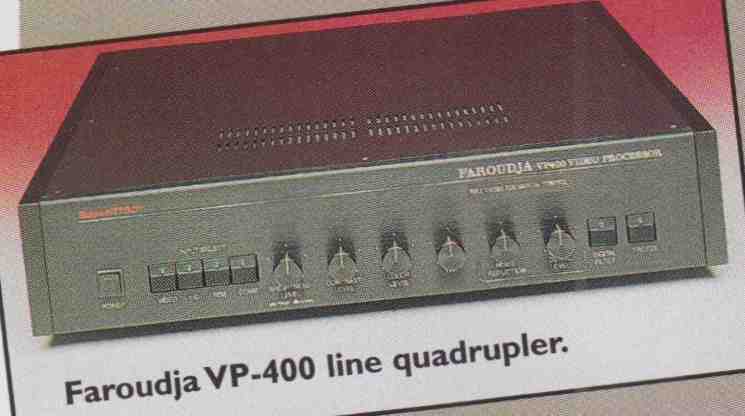The standard by which a “serious” home theater is judged is a movie theater, which of course means a BIG screen.

---Faroudja VP-400 line quadrupler
But our 40-year-old NTSC television system wasn't designed for big-screen viewing, and when it's watched that way, the picture starts to fall apart.
Previously invisible scanning lines become conspicuously evident, and the system's limited resolving power shows up as a soft, defocused image Resolution can be improved, up to a point, by using a wider-bandwidth monitor and viewing laserdiscs or satellite transmissions instead of broadcasts or video cassettes, but eventually you bump into the stonewall limits of NTSC video. That's where line doublers come in.
A single frame of NTSC video is not scanned (drawn on the screen) all at once; it's scanned in two 'passes," with the lines of the second scan filling the spaces between the lines of the first. This "inter laced" scanning relies heavily on a physiological phenomenon known as "persistence of vision"-the tendency for an image to "finger" for a fraction of a second in our visual memory after it is turned off. In theory, persistence of vision is supposed to merge the two sets of scans into a seamless quad field, but the fact that we still see scanning lines is proof that it doesn't quite work.
While most sales clerks and videophiles know that line doublers-also called scan multipliers or scan doublers-get rid of scanning lines, there's wide-spread confusion about how they work Line doublers do not actually increase NTSC's standard 525 line resolution to 1150 lines. (Actually, only about 495 of the 525 lines are used for screen imaging the rest, which are off-screen, carry synchronization and quality-monitoring information which are of interest only to techies ) What doublers do is display the same 525 lines twice as often. Instead of two alternate interlaced scans every thirtieth of a second, a line doubler paints all the scan lines twice during that period. The result? The lines virtually disappear.
But there can be side effects which are arguably worse than visible scan lines. Without additional processing, a scan-multi plied image looks even softer than an interlaced image, so all decent scan multipliers also incorporate circuitry that sharpens object outlines. And the digital processing needed to do this is sometimes subject to information overload: Lots of on-screen movement can demand faster processing than the system is capable of, forcing it to skip over "chunks" of data so as not to fall behind. Moving parts of the picture may break up into small rectangular blocks or develop little white "pin holes." The most sophisticated scan multipliers don't do this, but less expensive ones are still more or less susceptible to it.
And speaking of sophistication, the latest product from Faroudja Laboratories, the VP 400, doesn't merely double the scan rate-it quadruples it.
Unlike a doubler, the “Quad” really does effectively double the number of scan lines from 525 to 1150. It does this by "interpolating" completely new scan lines between the originals, deriving brightness and color information from the originals above and below. Too bad it costs $20,000! But with a projector capable of taking full advantage of the VP-400 (and only the most high-end models are), the picture is so amazingly film-like it makes the prospect of waiting for true high-definition TV much easier.
== == ==
[adapted from 1996 Stereophile Guide to Home Theater article]